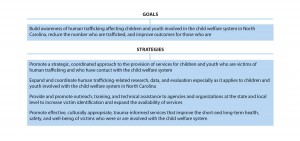Human Trafficking: Project No Rest
The goal of Project NO REST (North Carolina Organizing and Responding to the Exploitation and Sexual Trafficking of Children) is to increase awareness of human trafficking affecting children and youth age 25 and younger in North Carolina, especially those involved in the child welfare system, to reduce the number of these youth who are trafficked, and to improve outcomes for those who are trafficked. This goal is being accomplished by bringing together government agencies, organizations, and stakeholders to develop a comprehensive and coordinated plan to address human trafficking of these youth. Through the development of this plan, North Carolina’s infrastructure for dealing with human trafficking issues, especially the trafficking of youth, will be strengthened and more effective. In addition to creating the plan, NO REST will implement a set of pilot projects that use the comprehensive plan for trafficking prevention and to provide services to youth who are identified as victims of trafficking. Experiences and lessons learned in the implementation of the projects will be used to develop a tool kit that provides a template for implementing similar efforts in counties across the state and throughout the country. Existing data sources will be mined and explored to develop valid and reliable estimates of the size of the human trafficking problem in the state. Additional sources of information will be developed to inform prevention and intervention efforts. Information developed from this project will be widely disseminated across the state and, through networks, and made available across the country.
This project is pursuing 4 strategies drawn from the Federal Strategic Action Plan on Services for Victims of Human Trafficking in the United States 2013-2017 (President’s Interagency Task Force, 2014). (See Figure 1.) Our first strategy is to develop an integrated, coordinated system for providing services to youth victims of human trafficking, especially those
Figure 1: Project NO REST Goals and Strategies
(click image to enlarge)
who are involved in the child welfare system. Second, the project will expand and coordinate human trafficking-related research, data, and evaluation relevant to youth victims of human trafficking. Third, we will provide training and technical assistance to state and local agencies and organizations to increase victim identification, promote outreach, and expand the availability and accessibility of services to victims. Fourth, we will promote the use of effective, culturally appropriate, trauma-informed services to improve the short- and long-term health, safety, and well-being of youth victims of human trafficking, especially those who are involved in the child welfare system.
The short-term outcomes that are being pursued by the project are:
- Expanded awareness of the trafficking of children and youth, especially those who are involved in the child welfare system
- Improved cooperation and collaboration at the state and local levels among stakeholders and agencies that serve trafficking victims
- Development of policies and quality practices designed to prevent youth, especially those involved with the child welfare system, from becoming trafficking victims
- Improved policies and practices to identify trafficking victims
- Improved capacity to serve trafficking victims
- Expanded outreach services to children and youth who are trafficking victims
- A safe and secure place to live and heal for trafficking victims, especially those who are involved with the child welfare system
- Increased use of evidenced-based, trauma-informed services and practices
- Reduction in trauma for children and youth identified as victims of trafficking


